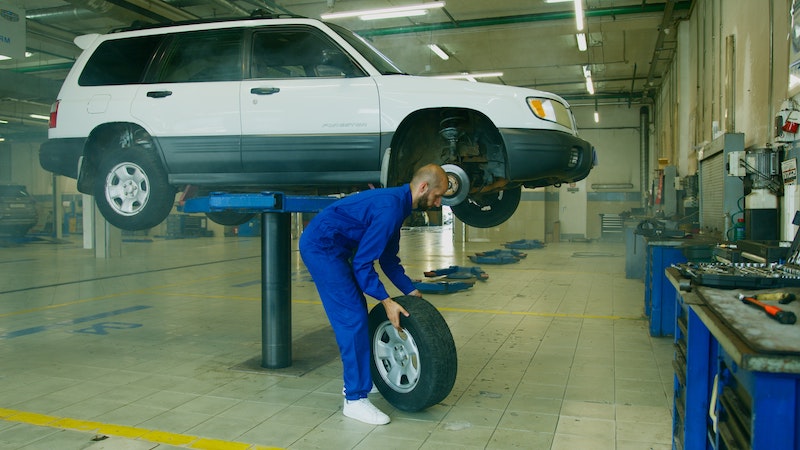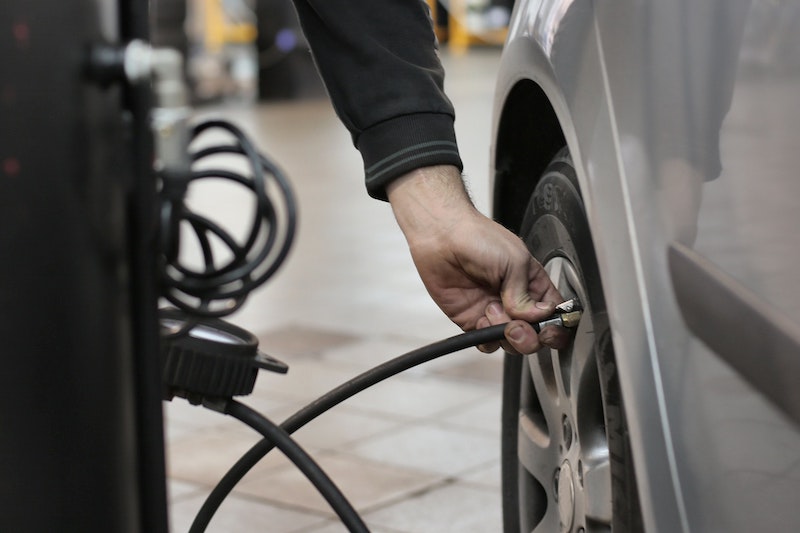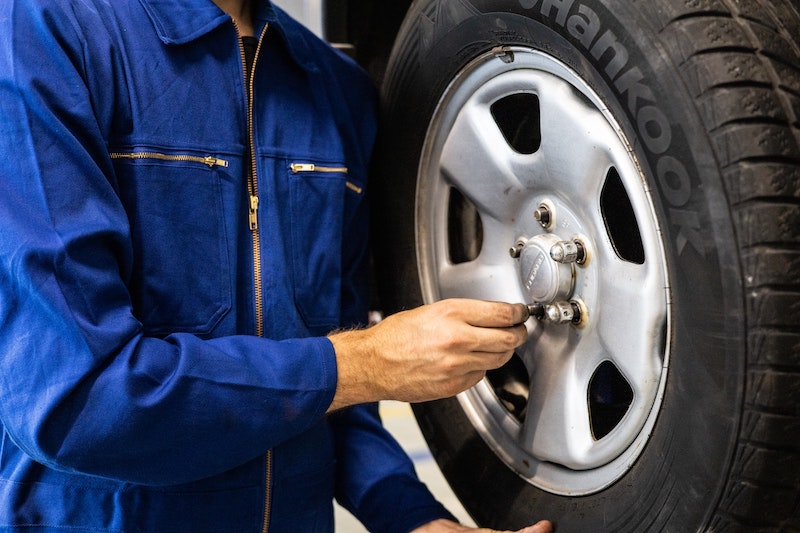You’re about to head out for your daily commute, only to discover a dreaded flat tire. Your mind instantly darts to questions like—what the heck am I supposed to do now? And how much is it going to cost to fix this?
The average cost to repair a tire in 2025 ranges from about $20 to $50, but some specialized fixes can cost $100 or more.
Let’s get into the nitty gritty of what goes into the cost of tire repair, so you can navigate these literal road bumps with confidence.
What are some of the most common tire repair issues, and how much does it cost to fix them?

Flat tire
What does this mean? Your tire has lost all its air and is, well… flat.
Typical causes:
- A sharp object—like a nail, or a shard of glass—punctured the tire
- The valve stem got damaged (that tiny tube where you pump air in)
- Your tire suffered some damage to its sidewall by scraping against a curb, road hazards, or even manufacturing defects
How is it fixed and how much does it cost? Depending on the cause, it may require a patch, plug, or even a replacement. Typically, a patch or plug costs roughly $20 and $50, while a new tire can run upwards of $100. Sidewall damage often can’t be safely patched, which means you’ll probably need a new tire.
Bead damage
What does this mean? The part of your tire that grips the rim is damaged.
Typical causes: Your tire was improperly mounted when it was put on the rim, or improperly dismounted when it was removed; hitting a pothole at the wrong angle can also cause this damage.
How is it fixed and how much does it cost? This damage might require a new tire or resealing the bead. The cost can range from $50 to $150, depending on the severity and tire type.
Tire tread wear
What does this mean? The grooves on your tire, which give it grip on the road, are getting shallow.
Typical causes: Regular driving wears out the tread over time. Uneven wear can be caused by improper tire pressure, misalignment, or failing to rotate the tires.
How is it fixed and how much does it cost? If wear is extreme, you’ll need a tire replacement. For minor issues, a tire rotation (changing the position of tires on your car) can help, costing around $40 to $80. A new tire can be upwards of $100.
How can I prevent tire damage?

Taking some preventative measures could save you a trip to the repair shop. Consider these quick tips:
- Maintain tire pressure: Regularly check and adjust the air pressure in your tires, which can prevent sidewall damage and ensure that your tire tread—the part of the tire that contacts the road—wears evenly. Learn more about how you can check your car’s tire pressure like a pro here.
- Avoid potholes and road hazards: Sometimes easier said than done, but steering clear of obstacles can help prevent punctures and blowouts.
- Rotate your tires regularly: You shouldn’t drive more than 10,000 miles without getting your tires rotated. Tire rotation ensures even wear, which can prevent sudden flat tires.
- Invest in quality tires: Not all tires are created equally. Trusted tire manufacturers—like Michelin, Continental, and Goodyear—often produce more resilient products, and might come with better warranty policies. Consult with an authorized car brand dealer about the best tires for your ride.
Keep in mind: Tire damage isn’t 100% avoidable. Even with the best preventative car maintenance, sometimes a stray nail or an unavoidable pothole can result in damage.
What factors impact the cost of tire repair?
It costs about $20 to $50 on average to repair a damaged tire, but there are several factors that can influence the final bill, including:
- The level of damage: A simple patch job will cost less than a full tire replacement
- Where the damage is: Punctures on the tire tread can be patched or plugged, while sidewall damage might require a new tire
- Type of tire: Specialty tires—like radial ones—or larger tire sizes might hike up the repair cost
- Tire age: Older tires might be better off replaced than repaired, which can be pricier than a fix
- Where you repair: Prices can vary between a local auto shop, big-name auto repair centers, or a dedicated tire shop
- Warranties: If your damaged tire is under warranty from a tire manufacturer or retailer, your repair or tire replacement might be discounted or free
Shop around for quotes, and prepare a list of questions you want to ask, before handing over your keys to a repair shop.

FAQs about tire repair
What’s the difference between a tire patch, tire plug, and tire replacement?
There are a few different actions that repair shops might take for a damaged tire. Let’s break down what they mean. Tire patch: When your tire has punctures in the main tread area, it can be patched using a piece of rubber placed on the inside of the tire to cover a hole. Tire plug: When your tire has small holes in it, pushing a sticky, rubbery string into the punctures from the outside can be a temporary solution, until a patch can be applied or the tire can be replaced. Tire replacement: If the damage to the tire is too severe for patching or plugging—like sidewall damage, or when the tread is too worn down for safe driving—swapping the damaged tire out with a completely new one is the recommended choice.
Is it OK to drive on a flat tire?
No. You should never drive on a flat tire—unless your car has run-flat tires (RFT), which in some cases you can drive on for up to 50 miles at a lower speed, so you can get to a safe place or a repair shop. Driving on a flat tire can damage your rim and make it more difficult to control your car. If you have a flat tire, you should safely pull over to the side of the road and call for roadside assistance. When you drive with Lemonade Car and include roadside assistance coverage on your policy, we’ll send the cavalry to help change out your flat tire (if you have an inflated spare tire), or give it a tow to the repair shop.
What are the signs of a tire that needs to be repaired?
If your tire is obviously flat, there’s not much mystery. But also look out for these signs that might indicate your tire needs to be repaired:
- A bulge or tear in the tire
- A nail or screw stuck in the tire
- The tire is leaking air—it might appear a bit deflated, or you might hear a consistent hissing sound if you get close
- The tire is worn down to the wear bars
- The tire is making a strange noise when you drive
If you notice any of these signs, you should have your tire inspected by a certified technician right away.
How often should I get my tires rotated?
You shouldn’t drive more than 10,000 miles without getting your tires rotated. Rotating your tires helps to evenly wear them down and prevents them from cupping or feathering.
When should I replace my tires?
Here are some guidelines to help you determine when to replace your tires:
- Tread depth: The National Traffic Highway Safety Administration reports that tires are not safe and need to be replaced when the tread is worn down to 2/32 of an inch. Many tires have wear bars that become visible at that depth, but you can also check the tread depth yourself using the tire penny test.
- Age: Even if the tread is not significantly worn, tires age and degrade over time. Most tire manufacturers recommend replacing tires that are six to ten years old, or every 36,000 to 75,000 miles, regardless of tread depth.
- Visible damage: Check for cracks, cuts, punctures, bulges, or other defects on your tires. If you see any of these issues, it’s a good idea to have the tire inspected by a professional and possibly replace them.
- Vibration or unusual noises: If you feel unusual vibrations while driving (and other potential causes have been ruled out), it might be an internal problem with the tire.
- Driving conditions: If you frequently drive on rough or unpaved roads, you may need to replace your tires more frequently.
Which states currently offer Lemonade Car insurance?
Arizona, Colorado, Illinois, Indiana, Ohio, Oregon, Tennessee, Texas, and Washington.
A few quick words, because we <3 our lawyers: This post is general in nature, and any statement in it doesn’t alter the terms, conditions, exclusions, or limitations of policies issued by Lemonade, which differ according to your state of residence. You’re encouraged to discuss your specific circumstances with your own professional advisors. The purpose of this post is merely to provide you with info and insights you can use to make such discussions more productive! Naturally, all comments by, or references to, third parties represent their own views, and Lemonade assumes no responsibility for them. Coverage and discounts may not be available in all states.




